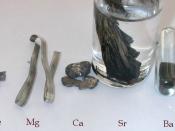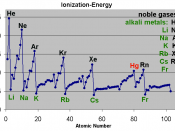AbstractThe rates of reaction of Alkali metals and Alkaline Earth meatals are compared in this lab. The pH of each of the resulting metal solutions are tested and the products of the reaction between calcium and water is discovered. The tested elements are sodium, lithium, potassium and calcium and each of them were placed in a beaker filled with water. The resulting solutions pH levels were tested with litmus paper. There were more steps for caclium because it is the only Alkaline Earth metal. For calcium, the gas produced in a test tube by the downward displacement of water was collected. Then, the test tube was lifted out of the water and kept in an inverted position. Finally, the gas collected was tested by bringing a burning splint to the mouth of the test tube. It was concluded that the Alkali metals were more reactice than the Alkaline Earth metals.
When the active metals reacted with water, the resulting solutions were basic. Hydrogen gas was produced when calcium reacts with water.
IntroductionÃÂAlkali metals are in the first column of the periodic table and they may be readily fused and volatilized with their melting and boiling points becoming lower with increasing atomic mass. They are the strongest electropositive metals.ÃÂ (Kerrod, R. 2009) These elements react vigorously, even violently with water. Alkaline Earth metals are elements in the second column of the periodic table. ÃÂThese elements are in general white, differing by shades of color or casts; they are malleable, extrudable and machinable.ÃÂ (Tutor Vista. 2008) Also, these elements are less reactive than the Alkali metals and have higher melting points and boiling points.
ÃÂThe ionization energy is the amount of energy it takes to detach one electron from a neutral atom. The IE increase from bottom to top and left to...


